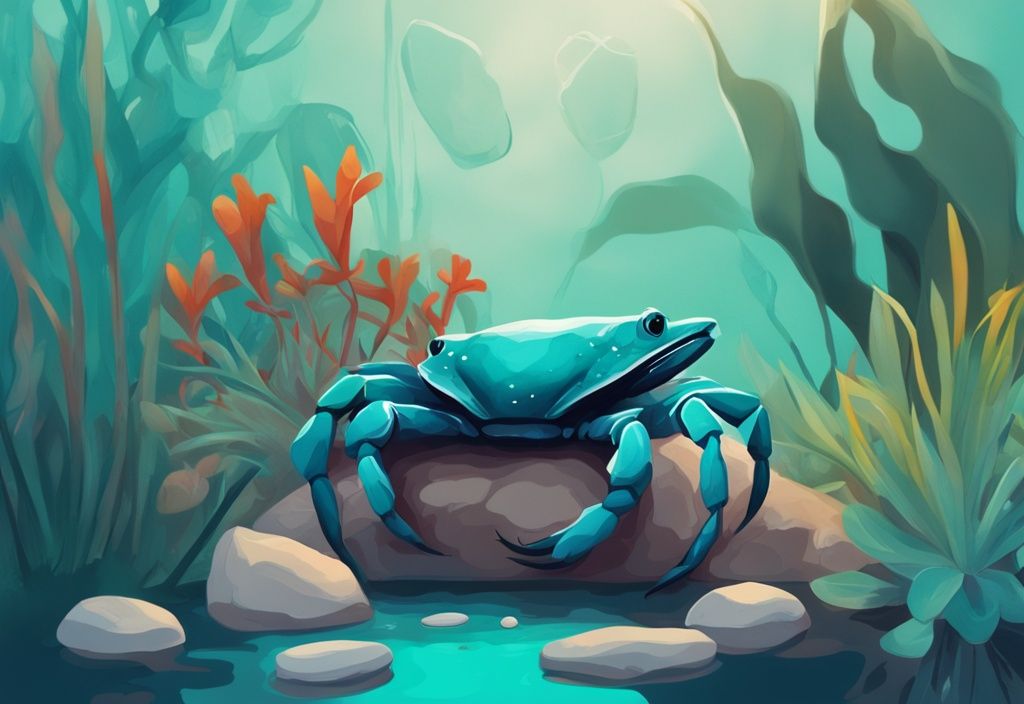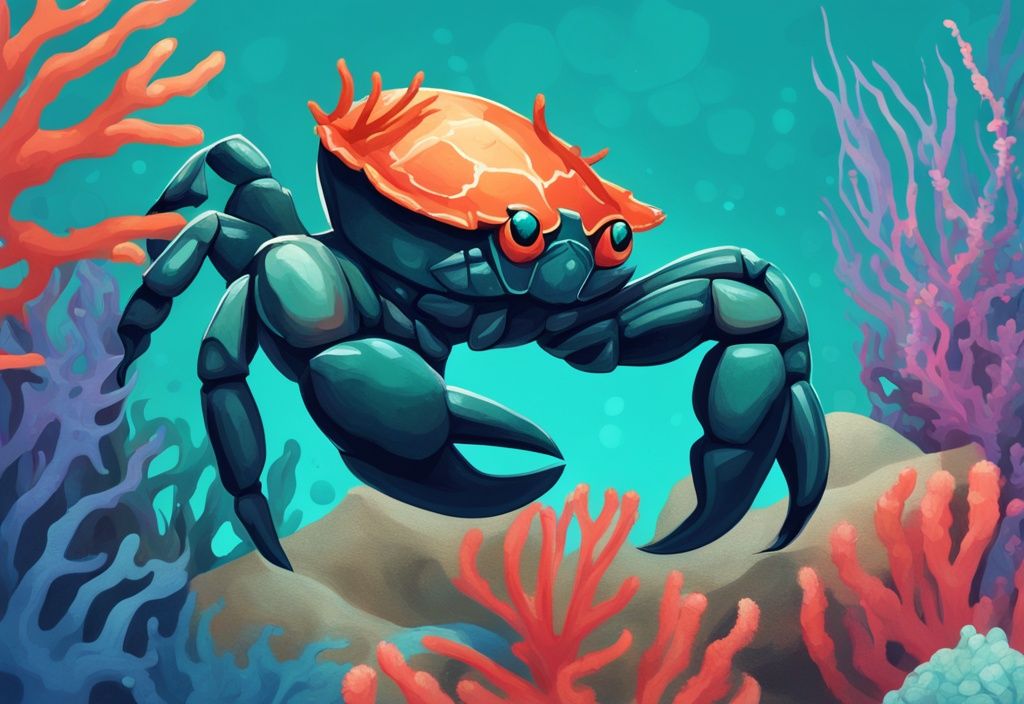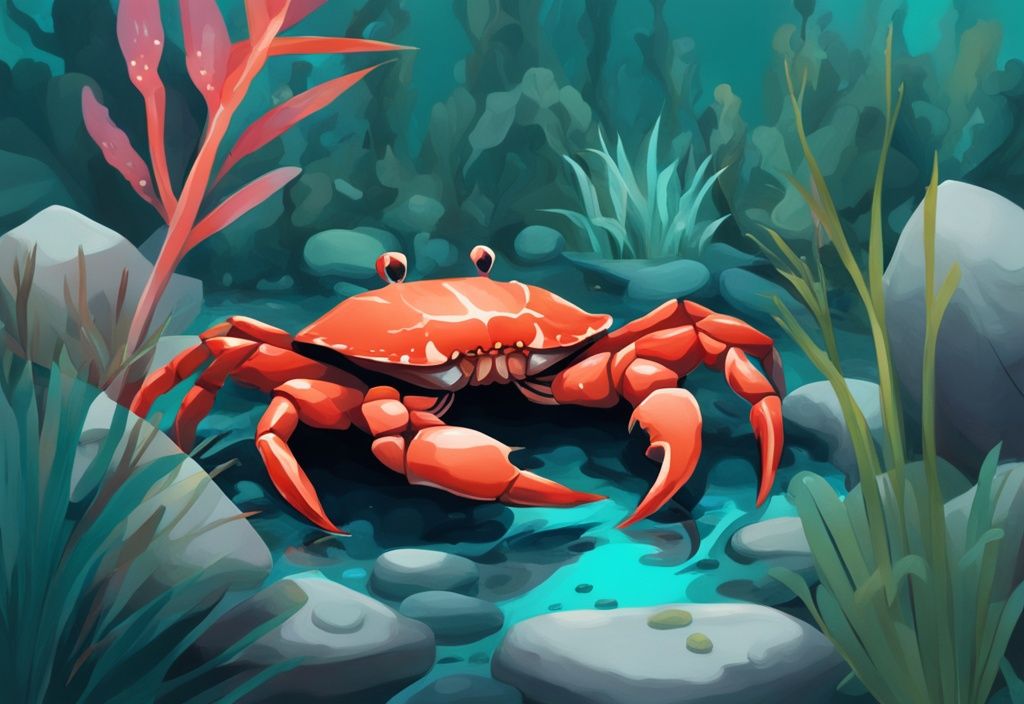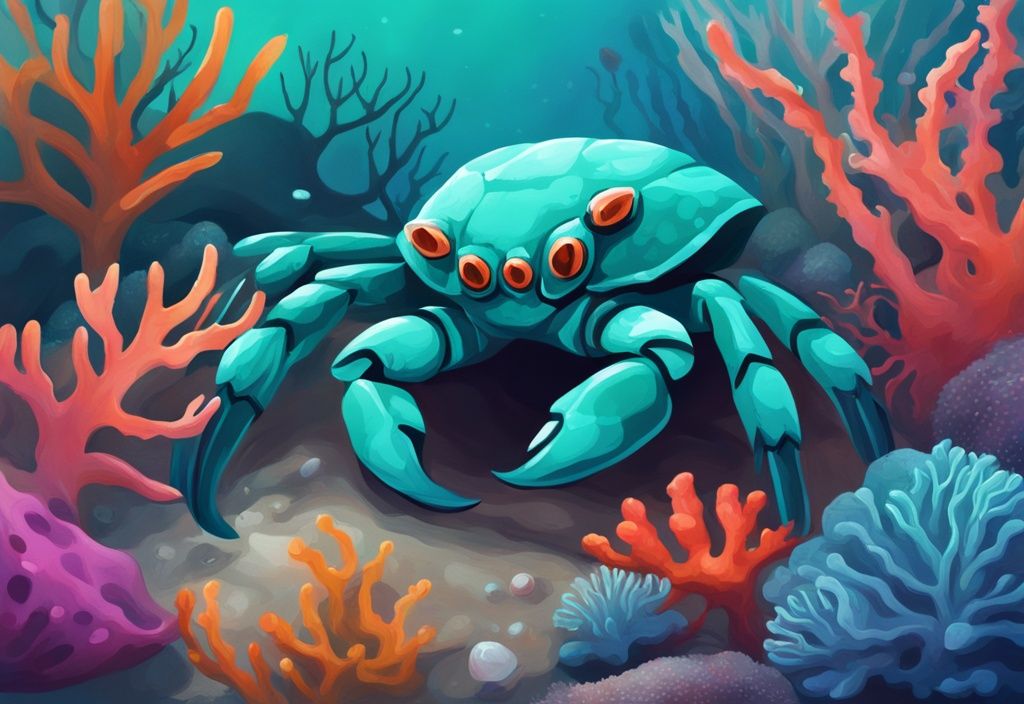Imagine a creature that combines the allure of a leopard with the mystique of the underwater world. Meet the Panther Crab, a captivating addition to any aquarium that promises to intrigue both novice and seasoned aquarists alike. Known scientifically as *Parathelphusa pantherina*, these crabs are celebrated for their distinctive spotted appearance and vibrant demeanor.
Originating from the freshwater habitats of Indonesia, Panther Crabs are not just visually striking but also fascinating in their behavior and adaptability. As we dive into this essential guide, you’ll discover everything from their ideal tank conditions to their omnivorous diet, ensuring you provide the best care for these aquatic wonders.
Whether you’re curious about their compatibility with other tank mates or interested in the challenges of breeding them in captivity, this article offers a comprehensive look into the world of Panther Crabs. We’ll also tackle common issues like aggression and shell health, ensuring your crabs thrive in their new home.
Join us as we explore the growing popularity of Panther Crabs in the aquarium trade, and consider the ethical implications and conservation efforts surrounding these remarkable creatures. Dive deeper into the essentials of Panther Crab care and transform your aquarium into a vibrant aquatic haven.
Introduction to Panther Crabs
Panther Crabs are a remarkable species that captivate both researchers and aquarium enthusiasts alike. These intriguing creatures are known for their unique appearance and behaviors, which are shaped by their natural habitats in Indonesia. Let’s delve into what makes these crabs so fascinating.
Scientific Classification and Description
Panther Crabs, or Parathelphusa pantherina, belong to the Gecarcinucidae family. First described by Schenkel in 1902, these crabs hail from the vibrant aquatic landscapes of Indonesia, particularly the rivers and streams of Sulawesi, including Lake Matano. This specific environment contributes to their distinctive traits, making them a subject of interest for many.
Distinctive Spotted Appearance
Imagine a vibrant orange canvas dotted with black spots, much like a panther’s coat. This is the striking appearance of the Panther Crab, which has made it a favorite in the aquarium trade. Their coloration is not just for show; it serves as a clever camouflage among rocky substrates and aquatic vegetation. This blend of beauty and functionality makes Panther Crabs a delightful addition to any aquarium, offering a splash of the exotic while blending seamlessly into their surroundings.
Keeping Panther Crabs in Aquariums
Panther Crabs are fascinating creatures that bring a unique charm to any aquarium. Understanding their needs is essential for creating a thriving environment that mirrors their natural habitat. Let’s delve into the specifics of water conditions, behavior, and compatibility to ensure your Panther Crabs flourish.
Ideal Water Conditions and Tank Setup
Panther Crabs flourish in aquariums that mimic their natural surroundings. They prefer clean, slightly acidic to neutral water, with a pH range of 7.5 to 8.5. These crabs are quite sensitive to changes in water quality and temperature, so regular monitoring is crucial. For those dealing with issues related to water quality, learning about Water Fleas in Aquariums can be beneficial. Imagine them as tiny escape artists; their climbing prowess necessitates a secure lid to prevent any adventurous getaways. Providing ample hiding places and a substrate suitable for burrowing caters to their natural instincts. Good filtration and regular water changes are your best friends in maintaining a healthy environment.

Behavioral Traits and Activity Patterns
As night owls, Panther Crabs are most active after the sun sets. Their territorial nature can lead to aggressive behavior, especially in cramped quarters. Picture them as the introverts of the crab world; they enjoy their space but can also thrive in a group. A 10-gallon tank can comfortably house up to five crabs, allowing them to establish a harmonious colony. Understanding these behavioral nuances is key to fostering a peaceful living space.
Tank Mates and Compatibility
Panther Crabs are generally compatible with a variety of tropical fish such as Tetras, Guppies, Mollys, Bettas, and Catfish. However, if not well-fed, they might eye larger, slow-moving fish as potential snacks. To ensure harmony, it’s vital to provide plenty of hiding spots, especially during molting periods. Think of these as cozy retreats that help maintain a balanced and peaceful tank community.
Feeding Your Panther Crab
Omnivorous Diet
Panther Crabs thrive on a varied diet that reflects their natural omnivorous habits. In their wild habitats, these crabs munch on a delightful mix of plant matter and protein sources. This diverse intake is crucial for their overall health and vitality. To mirror this in your aquarium, it’s essential to provide a balanced diet, combining both vegetation and animal-based foods. This approach not only ensures they get all the nutrients they need but also keeps them engaged, simulating their natural foraging behavior.
Recommended Foods and Supplements
To keep your Panther Crab healthy and vibrant, it’s vital to offer a variety of foods tailored to their dietary needs. Protein-rich options like brine shrimp and bloodworms are excellent choices, packed with essential nutrients that support growth and energy. Adding plant-based foods helps balance their diet. An important note: iodine supplements are crucial for Panther Crabs. They play a key role in maintaining healthy shell production. Regularly including these supplements ensures their exoskeleton remains strong and resilient, warding off potential shell-related health issues.
Breeding Panther Crabs in Captivity
Breeding Panther Crabs in captivity involves navigating a series of fascinating challenges and requirements. These intriguing crustaceans demand a habitat that mirrors their natural environment to thrive and reproduce. The female Panther Crab, akin to a diligent mother, cradles her eggs under her body until they hatch. This nurturing process requires a serene and stable setting, as any disturbance could disrupt the delicate development of the eggs. Ensuring optimal water conditions, such as precise temperature and pH levels, is crucial to support their breeding cycle. Moreover, providing a diet rich in nutrients and ample hiding spaces can significantly enhance the likelihood of successful breeding.
Challenges and Requirements for Breeding
Breeding Panther Crabs is like orchestrating a delicate symphony. The key is to create a controlled environment that mimics their natural habitat. The female plays a starring role, carrying her eggs with care. To support her, a stress-free and stable environment is essential. Imagine trying to bake a cake in a storm—any disturbance could spell disaster. Maintaining ideal water conditions, including temperature and pH, is vital. Additionally, a nourishing diet and cozy hiding spots can facilitate the breeding process.
Lifecycle and Reproduction Process
The lifecycle of Panther Crabs is a captivating journey, beginning with the female’s careful guardianship of her eggs. These eggs require a stable environment with precise water parameters to develop successfully. Picture this: the eggs are like tiny treasures, needing the perfect conditions to transform into young crabs. Once they hatch, these miniature marvels embark on their path to maturity. A suitable habitat, replete with hiding spaces and a balanced diet, is crucial for their growth and survival. By understanding and replicating these conditions, you can foster a thriving population of Panther Crabs in your aquarium.

Handling Panther Crab Issues
Creating a balanced aquarium environment is essential to manage the unique challenges posed by Panther Crabs. From their territorial tendencies to the intricacies of shell health, understanding these aspects can help ensure a harmonious aquatic habitat.
Handling Aggression and Territorial Behavior
Panther Crabs, with their feisty territorial nature, often remind me of my childhood cat, fiercely guarding her favorite chair. To keep the peace, it’s crucial to replicate their natural habitat. Imagine a cozy apartment with plenty of nooks and crannies—rocks, plants, and decorative caves can serve as these essential hideaways. These spaces offer the crabs a sense of security and personal space, which is key to reducing stress and minimizing confrontations.
Moreover, think of the tank as a bustling city; overcrowding can lead to tension. Ensuring ample space for each crab helps maintain a peaceful environment. Regularly observing their behavior is like being a detective, allowing you to make timely adjustments to the tank setup and ensure a harmonious community.
Maintaining Healthy Shell Production
The health of a Panther Crab’s shell is akin to our own skin—vital for protection and overall well-being. Iodine supplements are the unsung heroes here, crucial for promoting healthy shell production and aiding in the molting process. Regular supplementation ensures that the crabs have the essential nutrients to develop strong, resilient shells.
Equally important is the consistent monitoring of water quality. Imagine trying to breathe in a smog-filled city; maintaining optimal water conditions, free from pollutants and with stable pH levels, is essential for shell health. Regular water changes and efficient filtration systems play a pivotal role in achieving this balance. By prioritizing these aspects, you can ensure that your Panther Crabs thrive in their aquatic environment, much like a well-tended garden.
Panther Crabs in the Aquarium Trade
Panther Crabs have become a fascinating addition to the aquarium world, known for their vibrant appearance and lively behavior. This section delves into their popularity and the ethical considerations surrounding their trade.
Popularity and Demand
With their eye-catching orange bodies speckled with black spots, Panther Crabs are like the panthers of the aquatic realm. Their unique look and energetic antics have made them a favorite among aquarium enthusiasts across the globe. Imagine a tiny panther prowling through your aquatic setup—it’s no wonder they’re in high demand!
Not only do they bring a splash of color, but they also add a dynamic presence to any tank. Panther Crabs have become a must-have for both newcomers and seasoned aquarists eager to showcase these striking creatures. Their popularity isn’t just about looks; it’s about the lively character they bring to your underwater world.
Ethical Considerations and Conservation Efforts
Despite their charm, Panther Crabs face serious conservation challenges. Listed as Endangered on the IUCN Red List, their natural habitats in Indonesia are under threat from environmental degradation. This highlights the need for ethical practices in the aquarium trade.

As enthusiasts, it’s vital to ensure that your Panther Crabs are sourced responsibly. This means avoiding any contribution to habitat destruction. And remember, releasing these crabs into the wild can lead to them becoming invasive, which disrupts local ecosystems.
Conservation efforts are focused on preserving their natural habitats and promoting responsible ownership. By doing so, we can help safeguard the future of Panther Crabs in their native environments. Let’s keep these vibrant creatures thriving, both in our tanks and in the wild!
Frequently Asked Questions (FAQ)
What is the lifespan of a Panther Crab in captivity?
Panther Crabs, with their vibrant patterns and lively antics, can live between 5 to 10 years in captivity. Their longevity hinges on the care they receive and the conditions of their environment. Think of them as tiny, aquatic roommates who thrive with a bit of attention and a well-kept home.
Can Panther Crabs live with other fish?
Indeed, Panther Crabs can share their watery world with fish such as Tetras, Guppies, and Mollys. However, much like choosing the right neighbors, compatibility depends on the specific tank setup. Ensure there’s ample space and plenty of hiding spots to keep the peace. A harmonious tank is like a well-orchestrated symphony, where each creature has its own role and space.
What should I do if my Panther Crab becomes aggressive?
If your Panther Crab starts acting like the tank’s tough guy, it might be a sign of hunger or a need for personal space. Ensure it’s well-fed and introduce more hiding spaces. Think of these as cozy retreats that help curb its territorial tendencies. It’s akin to giving someone a comfy nook to unwind and relax.
Why is it important not to release Panther Crabs into the wild?
Releasing Panther Crabs into the wild can turn them into uninvited guests in local ecosystems. They might disrupt the delicate balance and pose a threat to native species. It’s a bit like inviting a party crasher who upsets the social dynamics. Keeping them in captivity ensures they remain part of a balanced and controlled environment.
Conclusion
Panther Crabs, with their striking appearance and engaging behaviors, offer a distinctive charm to aquarium enthusiasts. Their vibrant orange bodies adorned with black spots make them a captivating addition to any aquatic setup. However, these unique creatures require specific care to thrive in captivity. Ensuring optimal water conditions, providing ample hiding spaces, and maintaining a balanced diet are crucial for their well-being.
The allure of Panther Crabs in the aquarium trade underscores the importance of responsible ownership. As they are classified as endangered due to habitat destruction, it’s vital for aquarists to engage in ethical practices. This includes not releasing them into the wild to prevent ecological disruptions. By adhering to conservation efforts and promoting sustainable practices, enthusiasts can enjoy these fascinating creatures while contributing to their preservation.
